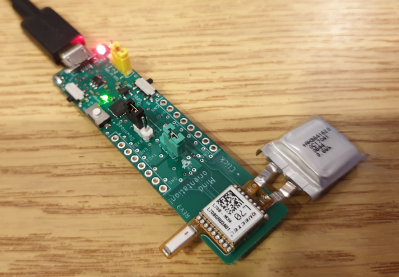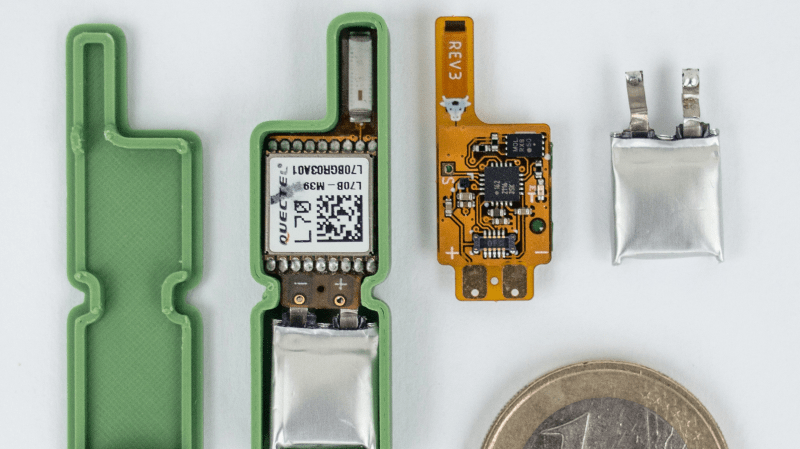[Trichl] has created a tiny GPS logger, called ‘TickTag’, designed as an inexpensive location tracking option for animal studies. The low cost, tiny form factor, and large power density of the LiPo battery give it the ability to track large populations of small animals, including dogs and bats.
The TickTag is capable of getting 10,000 GPS fixes from its 30 mAh cell. Each unit is equipped with an L70B-M39 GPS module controlled by an Atmel ATtiny1626 microcontroller and sports a tiny AXE610124 10-pin connection header for programming and communication. GPS data is stored on a 128 kB EEPROM chip with each GPS location fix using 25 bits for latitude, 26 bits for longitude, and 29 bits for a timestamp. Add it all up and you get 10 bytes per GPS data point (25+26+29=80), giving the 10k GPS fix upper bound.
To record higher quality data and extend battery life, the TickTag can be programmed to record GPS location data using variable frequency intervals or when geofencing bounds have been crossed.
Since the device is so small, any errant signals close to the antenna can cause problems with receiving. [Trichl] warns that when mounting the device it should be placed well away from any other tags or conducting material, including its own battery, which is required to be mounted behind the tag, not under, to avoid drowning out the GPS signal.

Getting data off of the TickTag requires physical access to the device which can be done via
a companion “user interface board”. The interface board integrates charging logic and USB communication, among other functionality, reducing complexity in the TickTag module itself.
The source code, Gerbers, design files, and 3D printable case are available on GitHub. Besides the documentation and source code, their paper in the Public Library of Science (PLOS ONE) journal is full of details, including the results of embedding a device on a canis lupus familiaris.
Who knows, maybe the TickTag is even resilient enough to be used to track the catus domesticus.















little typi for the number of pins of the AXE610124 connector ( 10, not 0 ), but every reader would see that ;) Aside from that, nice project ! :)
I was actually wondering what a 0-pin connector is.
Wifi
Wifi on a 30mAH battery? No way
The presented device doesn’t have a wireless interface. If you want access to the stored data, you have to catch the animal, remove the tag from it and open up the tag. Then you can plug the tag in its reader shown above.
A similar project is the (https://www.birdlife.org.au/afo/index.php/afo/article/download/2247/2269), which has a 1g tag which allows for wirelessly downloading the data. That tag might have other limitations. I didn’t check in detail.
Correction: the tag is 2.7g. The data can’t be read while the animal is still wearing the tag. They added an auto-release mechanism to retrieve the tags when birds arrive at a feeding station.
Lotek makes a very impressive piece of technology. It seems to be an ASIC with maybe some package-on-a-package construction. Very cool… if you can afford it.
You didn’t get the joke, I presume?
I see what you did there
I was thinking something like TAG-connect but much smaller. Personally, I would probably have used abed of nails, that only requires a few test pads on the board, which can even be spread around, so it would save weight, production cost and possibly board size, although in this case the size is determined by the SoC.
Thanks for the catch! It should be fixed now.
Very nice project. I might attach one to my neighbour’s cat who is currently sitting on my sofa licking it’s paws. Shame it does not have LoRa as I fear the owner’s might remove it before I get access to the data. Or, I could hook it up to some kind of geo-fencing device to stop it going back to it’s owner?
I’d say directly trying to steal/kidnap/catnap your neighbor’s cat is a bad idea, and I’m wondering why you would want to. I understand allowing a roaming cat into your house, but why not allow it to leave? And why would the data be useful?
You dont allow a cat to do anything. They just do it.
Thou shalt not covet thy neighbor’s cat!
B^)
It may be advantageous to add an interrupt based IMU for higher frequency logging and make the update interval for the GPS based on calculated distance traveled. Using FRAM would save more power but increase the pricetag. With the power savings, you could plausibly have a higher frequency mostly IMU logger and use the FRAM as a buffer that gets dumped into to cheap Flash memory.
ROHM builds Low Power Serial EEPROM. I see no advantage.
I am working on LoRa/GPS micro tracker (8x25mm, SAMR34, ZOE-M8Q) sewn into cat’s collar which will send GPS positon each hour and display it on the google map on the cell phone. Expected battery life is 3 months (3x Energizer 675 Zinc Air).
Cool ! Update me on your project please: tegwyntwmffat@gmail.com
I am using classic wire dipole antenna for GPS (and LoRa) around the cat’s collar. The GPS signal is very weak so I am just working on GPS amplifier (about 40 dB) to get boosted signal which can be process by the GPS chip.
https://forum.allaboutcircuits.com/threads/not-working-double-lna-gps-amplifier.184173/
If you make a GPS collar with a WiFi camera small enough for a cat you would be rich. I don’t mean the bulky ones or cubes…which is what is out there. If a camera can be in a writing pen it can be made for a cat. Everything out there is not good or too big. Can you do that?
It doesn’t make any sense to put heavy camera on the cat’s collar. I am just going to help pet owners to find their cat if he/she is lost somewhere.
In addition to a tiny camera, incorporate a laser pointer to turn on and off at random times.
This won’t work. Battery too small
I could do with one of these, but sewn into my son so he doesn’t forget it.
Hi Dan, just what I am looking for to keep tabs on my cat, she is often getting lost. can you make it available to buy? there is nothing available that is of any use, that doesn’t cost upwards of £40 to purchase and then you have to pay a monthly subscription costing the best part of £100.00 per year.
I still have a project to finish.
Thanks for getting back to me. Please let me know when you have finished development of the tracker and if it will be available to buy?
I’m also very interested in such device (price tag is not a major concern if the unit can provide positioning information at reasonable intervals). As a owner of Norwegian Forest Cat I had in the past many occuriancies when our pet “disappeared” for a couple of days, therefore GPS tracking would be a great solution.
Well, it’s more like the offlineternet of animals in this case. Unless you have long cable.
True, but doesn’t roll off the tongue as easily.
The following paper, which describes tiny wildlife tracking tags using non-GPS technology, might also be of interest:
https://arxiv.org/abs/2206.06171
The paper provides lots of technical details, and these tags are also open hardware, on CircuitHub.
I couldn’t find the hardware files anywhere. Do you have any links?
Paper looks great.
What does it weigh?
I expect to equip the locator with an LED light and a buzzer so that the cat can be tracked day and night at a given location (its last location according to the GPS) by a command from the mobile phone for, for example, 1 minute.